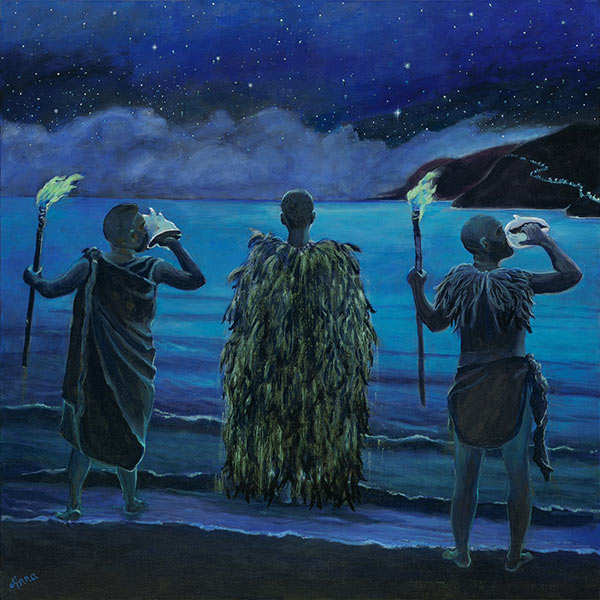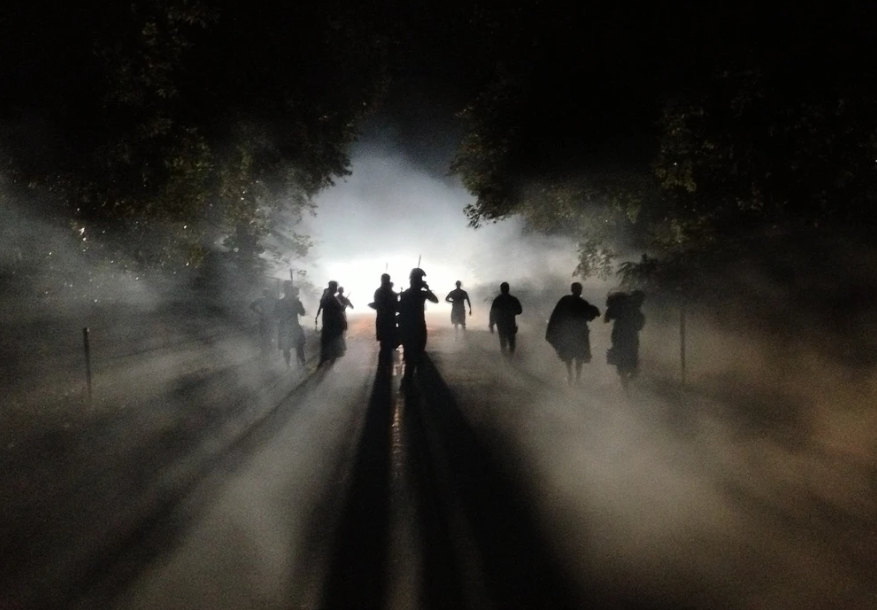There is hardly an uncle or aunty on the islands that has not heard of the ancient spirits that roam the islands and rule the night. Their supernatural tales instantly generate chicken skin and that sudden chill down your back.
This is the mo’olelo of the Night Marchers.
 Night Marchers, or Hukai’pō, are armed warriors adorned in brilliant costumes of ages past that continue their job in the afterlife that they performed in their former lives – protecting ali’i (chiefs) who were so sacred that the common man was never allowed to look at them. The consequence of disobeying this kapu (taboo) was death. In life, kindly chiefs supposedly took to traveling at night to avoid being spotted by commoners and subsequently leaving a bloodbath everywhere they went.
Night Marchers, or Hukai’pō, are armed warriors adorned in brilliant costumes of ages past that continue their job in the afterlife that they performed in their former lives – protecting ali’i (chiefs) who were so sacred that the common man was never allowed to look at them. The consequence of disobeying this kapu (taboo) was death. In life, kindly chiefs supposedly took to traveling at night to avoid being spotted by commoners and subsequently leaving a bloodbath everywhere they went.
 They can be recognized by their torches in a single file, chanting, thunderous pahu drums, and sometimes even theblowing of the pū, or conch shell, as a warning as they march. That’s when you know it’s time to run and hide. If you find yourself in their path, avert your eyes, strip naked and lie face down and play dead. (Some rumors say that peeing on yourself will keep you alive as the Marchers will move on from one they believe is mad.) No matter the scenario, you must hope that the ghost warriors take mercy on you. If not, you’ll hear a shriek of “o-ia!”, which means, “let them be pierced,” and that will be the end of you. If you are fortunate to have a distant ancestor among the warriors, they’ll shout “na’u”, which means “mine”, and the procession will pass you by without any harm.
They can be recognized by their torches in a single file, chanting, thunderous pahu drums, and sometimes even theblowing of the pū, or conch shell, as a warning as they march. That’s when you know it’s time to run and hide. If you find yourself in their path, avert your eyes, strip naked and lie face down and play dead. (Some rumors say that peeing on yourself will keep you alive as the Marchers will move on from one they believe is mad.) No matter the scenario, you must hope that the ghost warriors take mercy on you. If not, you’ll hear a shriek of “o-ia!”, which means, “let them be pierced,” and that will be the end of you. If you are fortunate to have a distant ancestor among the warriors, they’ll shout “na’u”, which means “mine”, and the procession will pass you by without any harm.

Ultimately, it would be smart to avoid them completely. Night Marchers are said to march on the last four Hawaiian moon phases before the new moon, and only after sunset and before the sun rises. They often frequent sacred grounds, such as heiau (temples), caves, and areas once reserved for ali’i. There are dozens of known Night Marcher trails all over O’ahu, including Ka’a’awa Valley, Yokohama Bay, Kaniakapūpū, Ka’ena Point, Kalama Valley, Waimānalo, and more.
Whether you believe these legends or write them off as a local superstition, consider yourselves warned…


 Facebook
Facebook
 X
X
 Pinterest
Pinterest
 Copy Link
Copy Link


